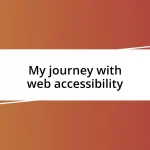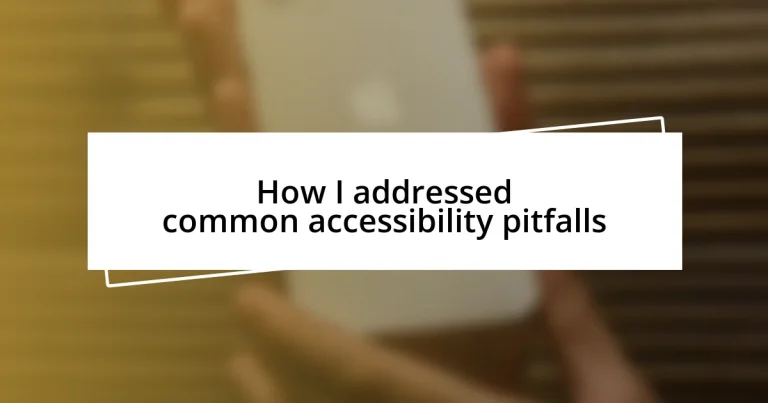Key takeaways:
- Understanding accessibility challenges is essential; empathy and awareness of diverse user experiences guide inclusive design practices.
- Common pitfalls in accessibility include ignoring alt text, non-standard color contrast, and neglecting keyboard navigation, all of which can significantly affect user experience.
- Continuous improvement and sharing lessons learned with others fosters a culture of inclusivity and enhances the overall effectiveness of accessibility efforts.
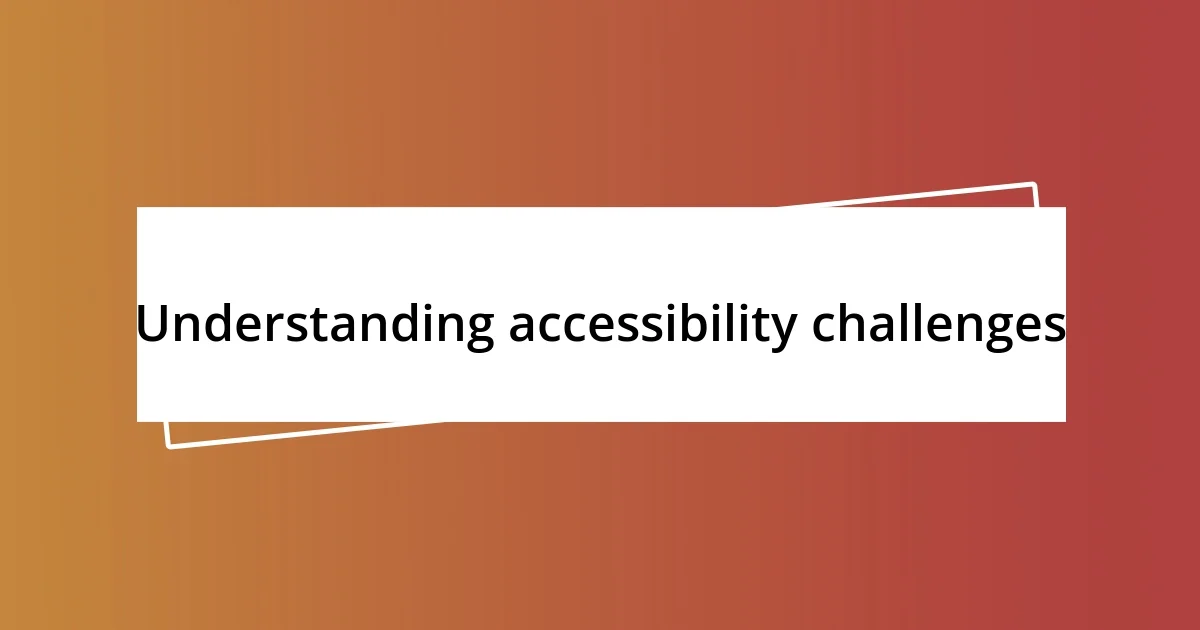
Understanding accessibility challenges
Understanding accessibility challenges is crucial for creating inclusive environments. I remember working on a project where we assumed everyone understood our online content without realizing that not all users had the same capabilities. It hit me hard when a colleague shared how difficult it was for visually impaired users to navigate our site; the emotional weight of those experiences propelled me to rethink our approach.
I often find myself pondering this: How often do we take our environments for granted? For many, simple things like curb cuts or screen readers are not just conveniences; they are essentials. This realization opened my eyes to the fact that accessibility challenges are deeply rooted in everyday interactions and can significantly hinder someone’s ability to access information or services they need.
Additionally, the emotional toll of constantly encountering barriers cannot be overlooked. I’ve spoken with individuals who shared their frustration and isolation when faced with inaccessible designs. It made me appreciate how vital it is to prioritize these considerations; empathy should drive our efforts in making spaces more navigable.

Identifying common pitfalls
When identifying common pitfalls in accessibility, one realization stands out: it often involves overlooking the needs of diverse users. For example, during a website overhaul, I initially thought that adding captions to videos was enough. It wasn’t until I received feedback from a friend who uses a screen reader that I understood the importance of ensuring all elements, like buttons and images, were properly labeled. This experience taught me that accessibility isn’t just an add-on; it’s an integral part of the design process.
Here are some typical pitfalls I’ve encountered:
- Ignoring alt text: Many images lack meaningful alt descriptions, which can leave visually impaired users in the dark.
- Non-standard color contrast: Assuming everyone can read light text on a pastel background often leads to confusion and frustration.
- Neglecting keyboard navigation: Designing only for mouse users alienates those who rely on keyboard shortcuts.
- Unclear instructions: Simplicity is key—jargon-heavy language can make it hard for individuals with cognitive disabilities to follow along.
- Inaccessible forms: Forgetting to label form fields or use accessible dropdowns can create substantial barriers.
Each of these issues can significantly diminish the user experience, making it imperative for us to address them head-on.
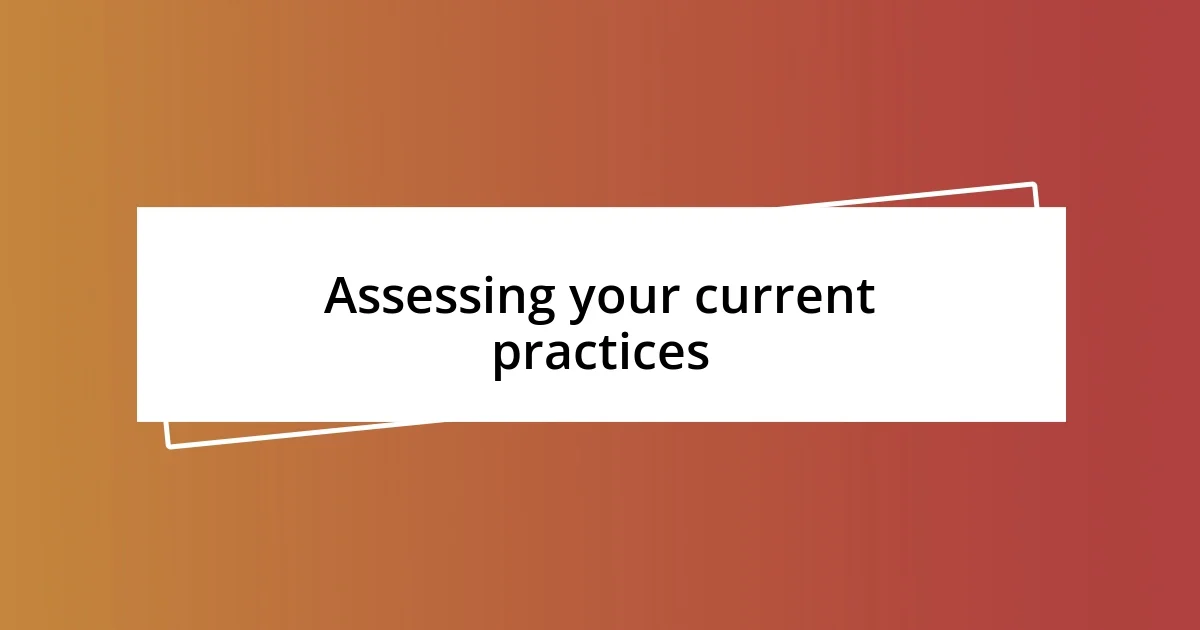
Assessing your current practices
Assessing current practices often requires a diligent audit of our existing systems. I recall a time when my team and I conducted a thorough review of our website’s accessibility features. While we prided ourselves on compliance, it was enlightening to discover that merely ticking boxes on a checklist didn’t capture the actual user experience. Seeing my team members engage with assistive technologies, however clunky at times, made me realize how essential it is to genuinely understand the barriers others face.
I found it helpful to create a feedback loop with users who experience accessibility challenges. After reaching out to a local disability advocacy group, we gained invaluable insights about their daily struggles. It was eye-opening to learn how small changes, like rewording jargon-heavy language, made a significant difference in usability for many. Their candid reviews reinforced my belief that involving real users in assessments ensures we’re not just checking off requirements but truly enhancing access for everyone.
To further drive the point home, performing a comparison of our practices against best practices can illuminate areas for improvement. This not only showcases our dedication to inclusivity but helps prioritize future initiatives. I often think about how essential it is to remain open to feedback, continuously refining our strategies to foster an environment that caters to all users’ needs.
| Current Practice | Best Practice |
|---|---|
| Basic compliance checks | User feedback integration |
| Minimal testing with accessibility tools | Hands-on testing with real users |
| Limited alt text use | Descriptive alt text for all images |
| Assuming color contrast suffices | Regular contrast ratio evaluations |
| Mouse-only navigation design | Full keyboard navigation support |
| Generic forms | Clearly labeled and accessible forms |
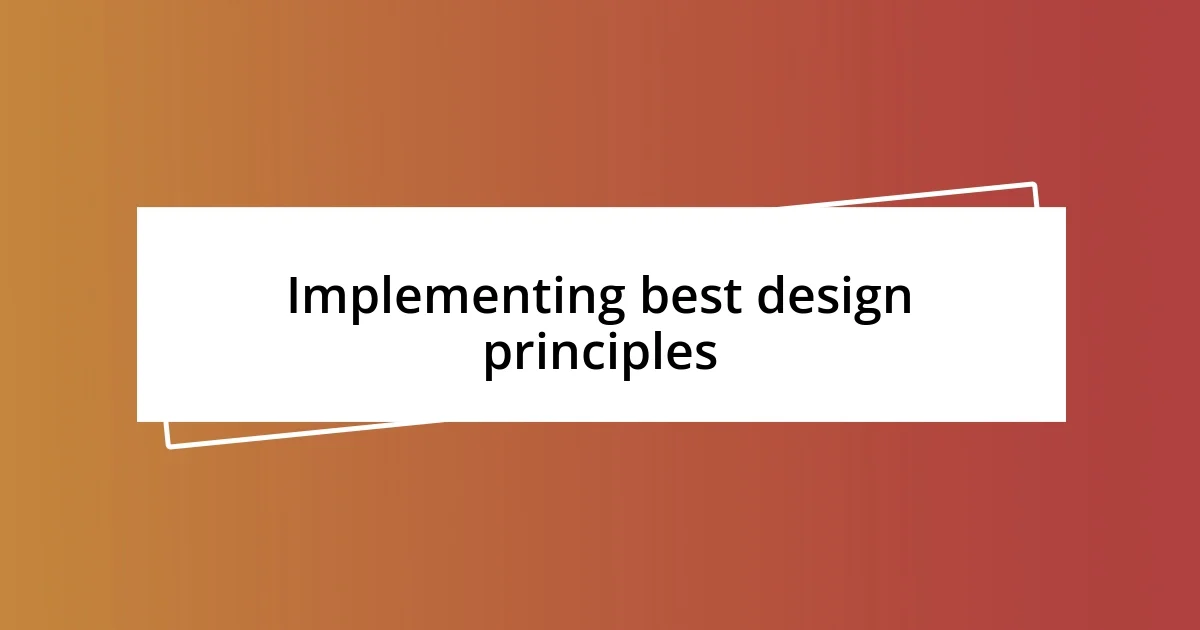
Implementing best design principles
Implementing best design principles requires a thoughtful approach. I remember redesigning a popular app where we focused on user-centric accessibility. One of the standout moments was when we shifted our color palette to accommodate users with visual impairments. The reaction from the community was overwhelmingly positive—people appreciated that we prioritized their needs, which made the app more usable for everyone and not just a select few.
An integral part of this process is embracing simplicity. I once worked on an online form that seemed straightforward to me, but after a few usability tests, I discovered users were confused. By revisiting the design, breaking down complex steps, and using clear, concise language, we made the form more engaging. Isn’t it fascinating how a few tweaks can lead to significant improvements in user interaction? I strive for clarity, as it helps bridge gaps for users who might otherwise feel overwhelmed.
Lastly, utilizing inclusive design practices isn’t just about compliance; it’s about empathy. I distinctly recall a workshop where participants shared their experiences with inaccessible websites. Their frustrations were palpable and made me reflect on my own past designs. I realized that incorporating feedback from diverse users isn’t just beneficial—it’s essential for creating a truly inclusive environment. Every element we design should resonate with users, ensuring that no one feels like an afterthought. Wouldn’t you agree that the true success of a design lies in how well it caters to everyone’s needs?
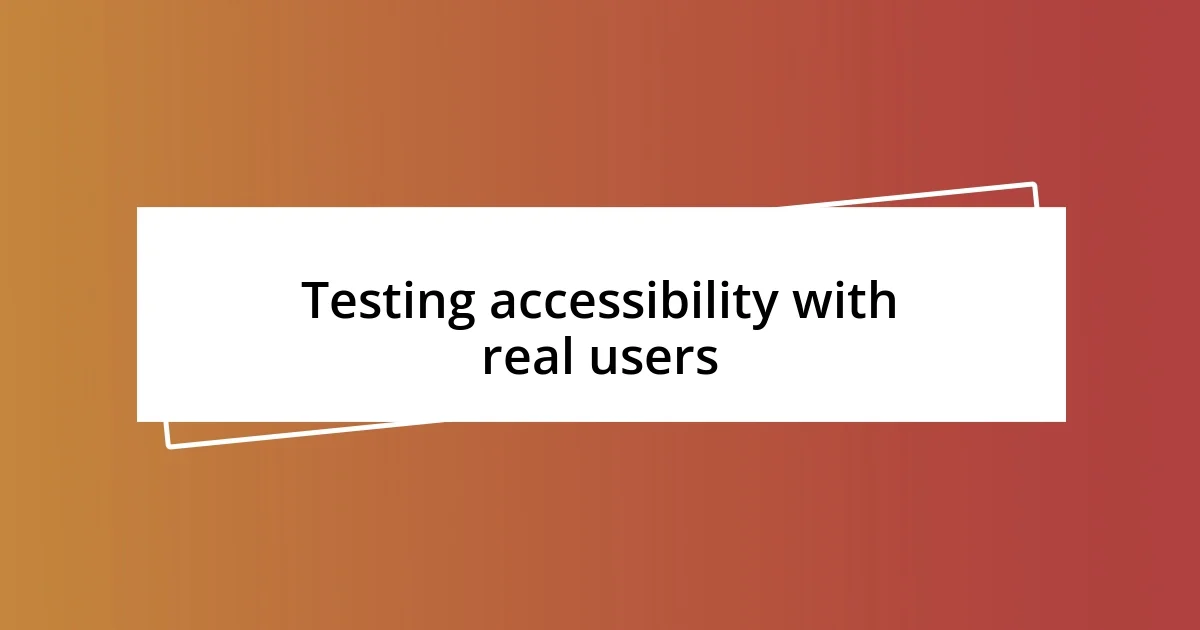
Testing accessibility with real users
In my experience, testing accessibility with real users is where the magic happens. I remember a particular session where we invited individuals with various disabilities to interact with our website. Watching them navigate through our features was both humbling and enlightening. It underscored the reality that even the most well-intentioned designs might fall short without real-world input. Have you ever noticed how the smallest details can have a profound impact? For instance, one user pointed out that our dropdown menus were nearly impossible to use with a screen reader, a simple observation that we could easily overlook.
I’ve also found that different perspectives lead to surprising discoveries. During another test, a participant who used a wheelchair struggled with the keyboard navigation we thought was fully functional. Their candid feedback prompted us to rethink our entire approach. This experience highlighted a valuable lesson: accessibility isn’t just about meeting specific standards; it’s about creating an environment where everyone, regardless of ability, can navigate seamlessly. How do we ensure we don’t miss these crucial insights? Engaging directly with users lets us tap into their unique experiences, shaping a more comprehensive understanding of what true accessibility looks like.
Relating personally to users’ experiences creates deeper empathy. I remember how a participant shared their frustrations with an online purchasing process that was cumbersome, impacting their ability to shop confidently. Their heartfelt accounts made me realize that accessibility issues often extend far beyond the screen. It’s about people’s lives and their day-to-day interactions with technology. When we authentically listen and adapt based on their input, the end product becomes not just accessible but genuinely user-friendly and inclusive. Wouldn’t you say that this approach not only enhances our designs but also enriches our understanding of the communities we aim to serve?

Continuously improving your approach
Continuously honing my approach to accessibility has been a journey of persistent reflection and adaptation. Just the other day, I revisited a project I thought was well-designed, only to recognize areas for improvement. It struck me how easy it can be to get comfortable with a “good enough” mindset. Have you ever revisited your work and realized there’s always room for growth? This experience reminded me that remaining open to change is vital in our pursuit of accessibility.
Feedback is an invaluable component of improvement. After implementing changes based on user insights, I noticed our shortened onboarding process significantly boosted user satisfaction. I can’t emphasize enough how liberating it felt to see our users flourish in ways we hadn’t anticipated. It was a stunning reminder that listening to our audience can lead to unexpected enhancements. How often do we pause to consider the voices that matter most? Embracing a mindset of continuous improvement means welcoming these perspectives with genuine enthusiasm.
The importance of continuous education can’t be overlooked. I’ve participated in numerous webinars and workshops focused on emerging accessibility trends. Each session has offered new strategies that have not only refined my skills but also deepened my understanding of diverse user needs. I vividly remember a presentation where a speaker discussed the nuances of color contrast beyond basic guidelines—it was eye-opening for me. Isn’t it exciting how each learning opportunity can transform our perspectives and practices? Regularly seeking out new knowledge equips us to better serve our users and push the boundaries of what’s possible in accessible design.

Sharing lessons learned and resources
Sharing lessons learned about accessibility has been a transformative part of my journey. I recall a particularly eye-opening workshop where we dissected the nuances of visual disability. One participant shared how frustrating it was to access charts and infographics that weren’t properly labeled. This kind of feedback reopened my eyes to details that I had previously brushed off. Have you ever felt that lightbulb moment when something you thought was insignificant revealed itself as a major barrier? It’s those stories that ground our design choices in real-world needs.
I often turn to online communities and resource hubs to expand my understanding. One day, while browsing a accessibility-focused forum, I stumbled across a guide on creating accessible PDFs. It was a game changer for me. Before that, I was blissfully unaware of the challenges my users faced with document accessibility. I remember the sense of accountability that washed over me—knowing that I could make a significant difference with simple adjustments. Isn’t it incredible how shared knowledge can instantly elevate our practice and enrich our professional lives?
As I reflect on the resources and lessons from my experiences, I find myself eager to share them with others. Whether it’s a blog post, a webinar, or an informal chat over coffee, these conversations foster a culture of learning. I had a colleague reach out after one of our discussions about mobile accessibility; they were inspired to make changes that dramatically improved their app’s usability. Sharing insights not only empowers others but also reinforces my commitment to a more inclusive future. How can we best cultivate this knowledge exchange? By championing open dialogues and actively participating in communities, we can build a network of shared growth and inspiration.









